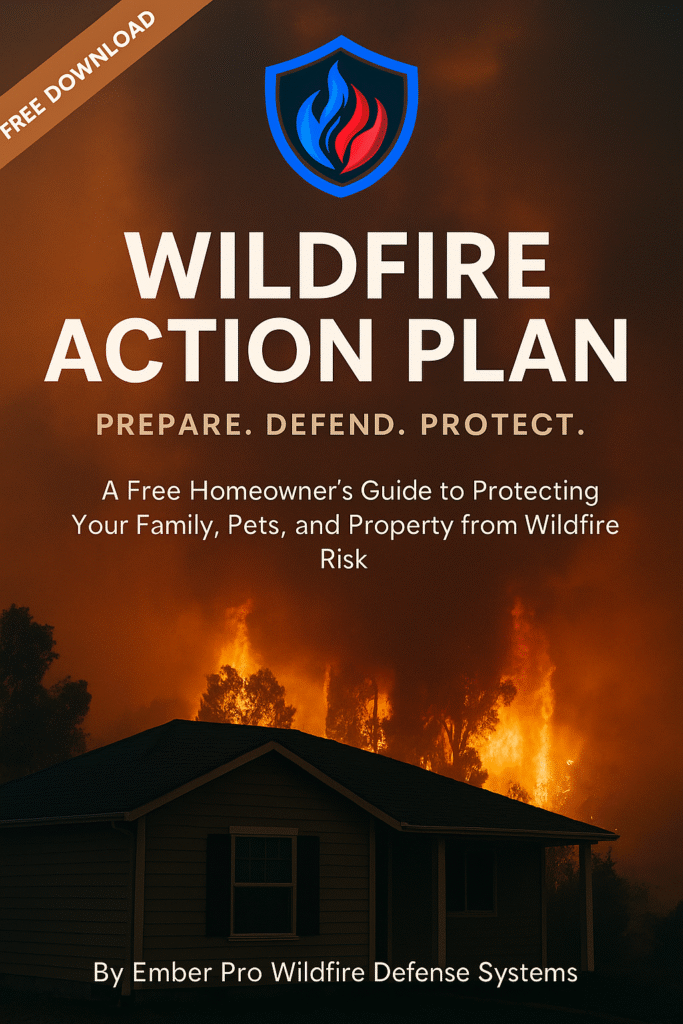Frequently Asked Questions About Ember Pro’s Wildfire Defense Systems
Ember Pro Wildfire Defense System (WFDS)
Video FAQ: What is the Wildfire Defense System?
🔥 What is the Wildfire Defense System?
Our Wildfire Defense System (WFDS) is a permanently installed protection system that uses only a non-toxic fire inhibitor to shield your property. The inhibitor has the same toxicity level as milk, making it safe for people, pets, and the environment. Irrigation heads are strategically placed to protect your roofline, eaves, decks, and defensible space.
For a deeper look at our fire protection systems and how they safeguard your home, see this guide.
🔥 How does the system work?
The WFDS connects to a dedicated supply of fire inhibitor and a high-pressure pump. From your phone, you can activate the system remotely. Irrigation heads spray a fine mist that coats your property, forming a protective barrier against embers and radiant heat. Here’s a step-by-step view of fire protection systems for wildfire home defense.
🔥 What area does the system protect?
Sprinkler heads are placed on the roof, under eaves, and around your property, extending up to 30 feet from your walls.
🔥 Why is this better than water-based systems?
Water evaporates within 15 minutes in wildfire conditions, leaving your home unprotected. Unlike water, our fire inhibitor does not evaporate, instead forming a long-lasting protective layer that resists ignition, even during direct flame contact. Read more on Why Wildfire Retardant Systems Work Better Than Water for Home Protection.
🔥 How do wind conditions affect performance?
Yes. We engineer every system with local wind patterns in mind. Irrigation heads are placed so that the fire inhibitor is carried into vulnerable areas during Santa Ana winds and other high-wind events. Our systems are also designed with 100% head overlap to compensate for wind shifts. See engineering research on ember exposure and home ignition.
🔥 What if there’s a power outage?
Our systems are off-grid capable with backup batteries and can connect to your Powerwall or generator.
🔥 Is it safe?
Absolutely. The fire inhibitor has the same toxicity as milk. The system uses durable copper piping, which can be color matched to blend into your home. Learn why wildfire home protection is about safety and peace of mind, not just structures.
🔥 How do I control the system?
The WFDS is fully remote-activated from your phone. Whether at home or miles away, you can turn it on instantly—essential during evacuations or red flag warnings.
🔥 What are the main benefits of installing a WFDS?
- Unmatched protection for your home and family
The ultimate benefit is peace of mind knowing your property and loved ones are safeguarded against wildfire threats. - Non-toxic fire inhibitor safe for families, pets, and landscaping
Our system applies a fire inhibitor with the same toxicity as milk, making it safe for families, pets, and landscaping. - Remote activation from anywhere
Control the system directly from your phone, whether you are home or miles away, ensuring protection when it matters most - Full coverage of roofline, eaves, decks, and property perimeter
Strategically placed irrigation heads defend your roofline, eaves, decks, and property perimeter where fire is most likely to spread. - Durable copper piping for strength and aesthetic discretion
Installed with copper piping that can be color matched to your home, combining strength, heat resistance, and aesthetic discretion. - High-wind reliability engineered for Santa Ana conditions
Engineered to perform even during strong Santa Ana winds and other severe wildfire conditions. - Insurance benefits through wildfire hardening discounts
Many insurers look favorably on properties that harden against wildfire risk, which may reduce premiums or help maintain coverage.
See how comprehensive wildfire home protection supports your family’s well-being.
Ember Pro Spray Service
Video FAQ: What is Your Wildfire Spray Service?
🔥 What is your wildfire spray service?
Our spray service applies a specialized non-toxic fire inhibitor to your home and property. Once applied, it creates an invisible shield that reduces the risk of your home catching fire from embers, sparks, or radiant heat. Think of it as sunscreen for your property during wildfire season. Here’s why wildfire retardant systems outperform water.
🔥 Is it safe for people, pets, and landscaping?
Yes. The fire inhibitor we use is so safe that it has the same toxicity as milk. It’s non-toxic, biodegradable, and safe for children, pets, and plants.
🔥 How long does the protection last?
Typically, Our fire inhibitor typically lasts 3 to 6 months, depending on weather conditions. Heavy rainfall (2 inch or more) can wash it away, so re-application is recommended after significant storms. More on how retardant protection holds up vs. water during fire weather.
🔥 How often should I have it applied?
We recommend spraying 2 to 4 times per year, depending on your property’s wildfire danger rating and seasonal risk. This ensures your home maintains consistent protection through the most vulnerable months.
🔥 Do you offer service packages?
Yes. We offer service model packages designed to give you more protection and savings. Many homeowners choose quarterly or seasonal packages for cost-effective, year-round coverage.
🔥 Why should I consider this service?
- Non-toxic protection: Safe for families, pets, and plants.
- Proven defense: Stops embers and sparks from igniting your home.
- Insurance benefits: Many carriers look favorably on proactive fire-hardening.
- Flexible service packages: Save more with recurring sprays.
- Peace of mind: Ongoing protection during peak wildfire season. See how wildfire defense systems provide year-round peace of mind.
Home Hardening for Wildfire Defense
Video FAQ: What is Home Hardening?
🔥 What is home hardening?
Home hardening means making improvements to your property that reduce the chance of your home catching fire. The goal is to keep flames, embers, and heat from reaching your house.
🔥 What are Zones 0, 1, and 2?
- Zone 0 – Immediate Zone (0–5 feet):
The most critical area. Keep it completely free of anything combustible. This means removing mulch, firewood, plants, and debris right next to the home. Use only non-combustible materials like gravel, stone, or concrete. - Zone 1 – Intermediate Zone (5–30 feet):
Create separation between plants, trees, and structures. Keep grasses mowed, remove ladder fuels (low branches that can carry fire up), and maintain defensible spacing between shrubs and trees. - Zone 2 – Extended Zone (30–100 feet):
Reduce fuel load. Thin vegetation, cut tall grasses, and space trees to slow the spread of fire and reduce its intensity before it reaches the home.
🔥 Why does home hardening matter?
Most homes are lost to embers and radiant heat. By hardening your home and maintaining defensible space in Zones 0, 1, and 2, you drastically improve your chances of surviving a wildfire and you can often qualify for insurance benefits.
Ember Vents
Video FAQ: What Are Ember Vents?
🔥 What are Ember Vents?
Ember Vents retrofit into your existing vents with a 1/16-inch mesh screen designed to block wind-driven embers from entering your home.
🔥 Why are they important?
Most home ignitions during wildfires begin when embers enter through vents. Ember Vents stop this risk while allowing proper airflow. Zone Zero guidance from CAL FIRE/Board of Forestry.
🔥 Do they change the look of my home?
No. Ember Vents are designed to blend seamlessly into your existing vent openings.
🔥 How effective are they?
They’ve been proven to dramatically reduce ember intrusion, the leading cause of wildfire home loss. They are a part of a successful wildfire protection systems strategy.
Wildfire Insurance FAQs
Video FAQs: Does Ember Pro Help with Insurance?
🔥 Will installing Ember Pro help with insurance?
Yes. In fact, we provide a Wildfire Risk Reduction Report for your insurer. Under California’s Safer from Wildfires regulation, insurers must offer discounts for risk-reduction actions like Ember Pro’s systems. How fire protection systems for wildfire home defense improve insurability.
🔥 What is the California FAIR Plan?
The FAIR Plan is California’s insurer of last resort. It covers basic fire perils at ACV unless you add endorsements. However, maximum coverage is typically $3M. Therefore, many homeowners still prefer private carriers when available.
🔥 Does homeowners insurance cover wildfire damage?
Usually yes. However, coverage in high-risk zones can be limited or expensive. Because of this, Ember Pro reduces your risk profile, making insurance more attainable. Understand coverage tradeoffs and mitigation paths beyond the FAIR Plan.
🔥 What should I look for in a wildfire insurance policy?
- Replacement cost coverage
- Loss-of-use/additional living expenses
- Liability and landscaping coverage
- Debris removal and code upgrade clauses
🔥 What if my insurance is canceled?
Cancellation in high-risk areas is increasingly common. Even so, you have options: shop new carriers or improve your risk profile by installing fire protection systems which can help you avoid or exit the FAIR Plan. In many cases, mitigation helps you retain or regain coverage.
🔥 How do I file a wildfire insurance claim?
- File immediately, with photos/videos
- Save all receipts
- Keep insurer communication records
- Avoid discarding damaged items until inspected
- If issues arise, consider a public adjuster if denied
🔥 Why prevention matters more than insurance alone
Insurance can’t replace your home’s memories. Since embers cause up to 90% of structure loss, proactive steps—like installing Ember Pro—are the most effective defense. Read more: Residential Wildfire Protection Systems: How Effective Are They?
🔥 How do I get Ember Pro installed?
- Schedule a consultation.
- Our team evaluates your property.
- We design a custom system.
- Installation is scheduled (2–5 days).
🔥 Is financing available?
Yes. We offer flexible financing options through trusted partners.
Start Now and Download Your Free Wildfire Action Plan

